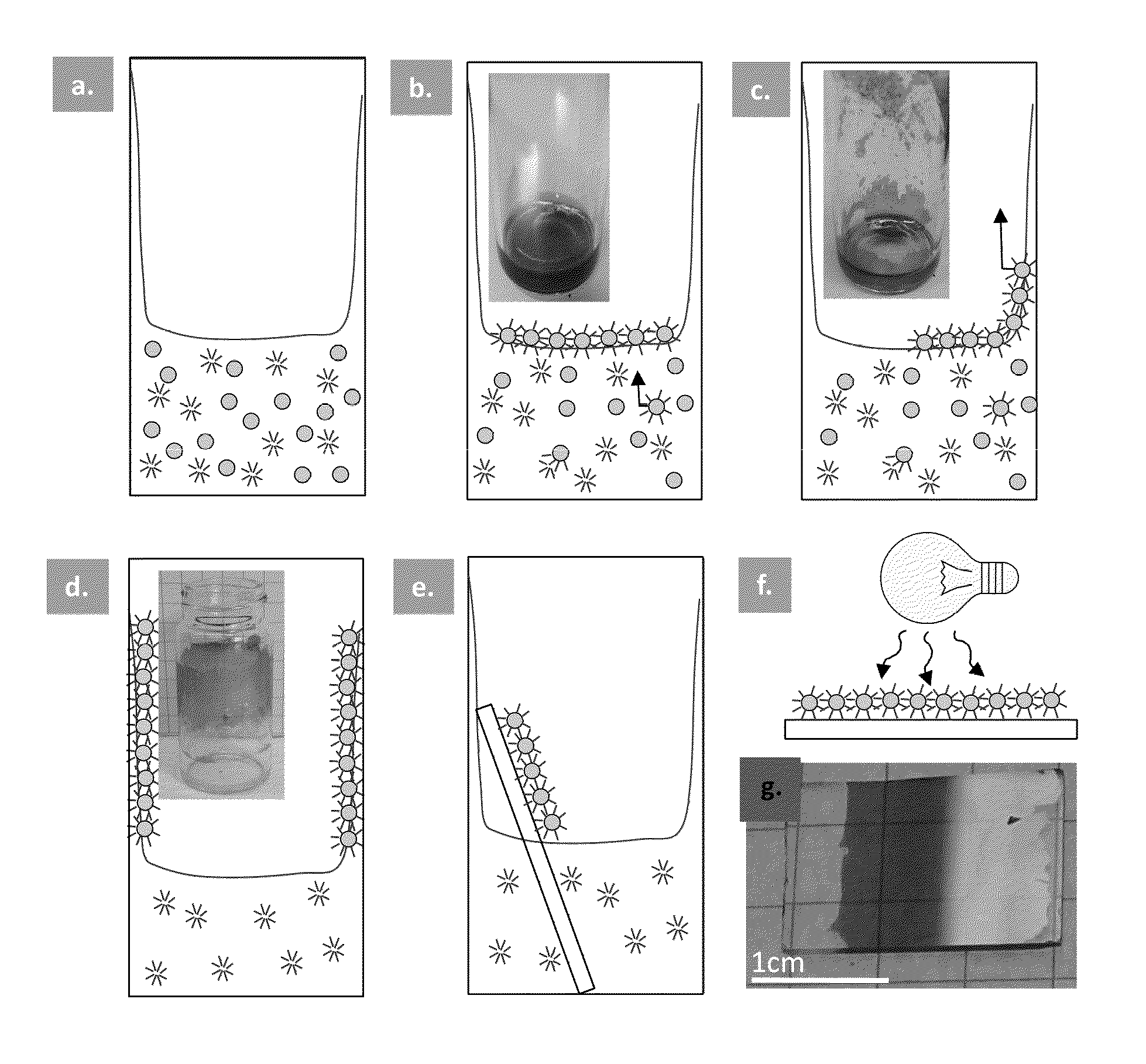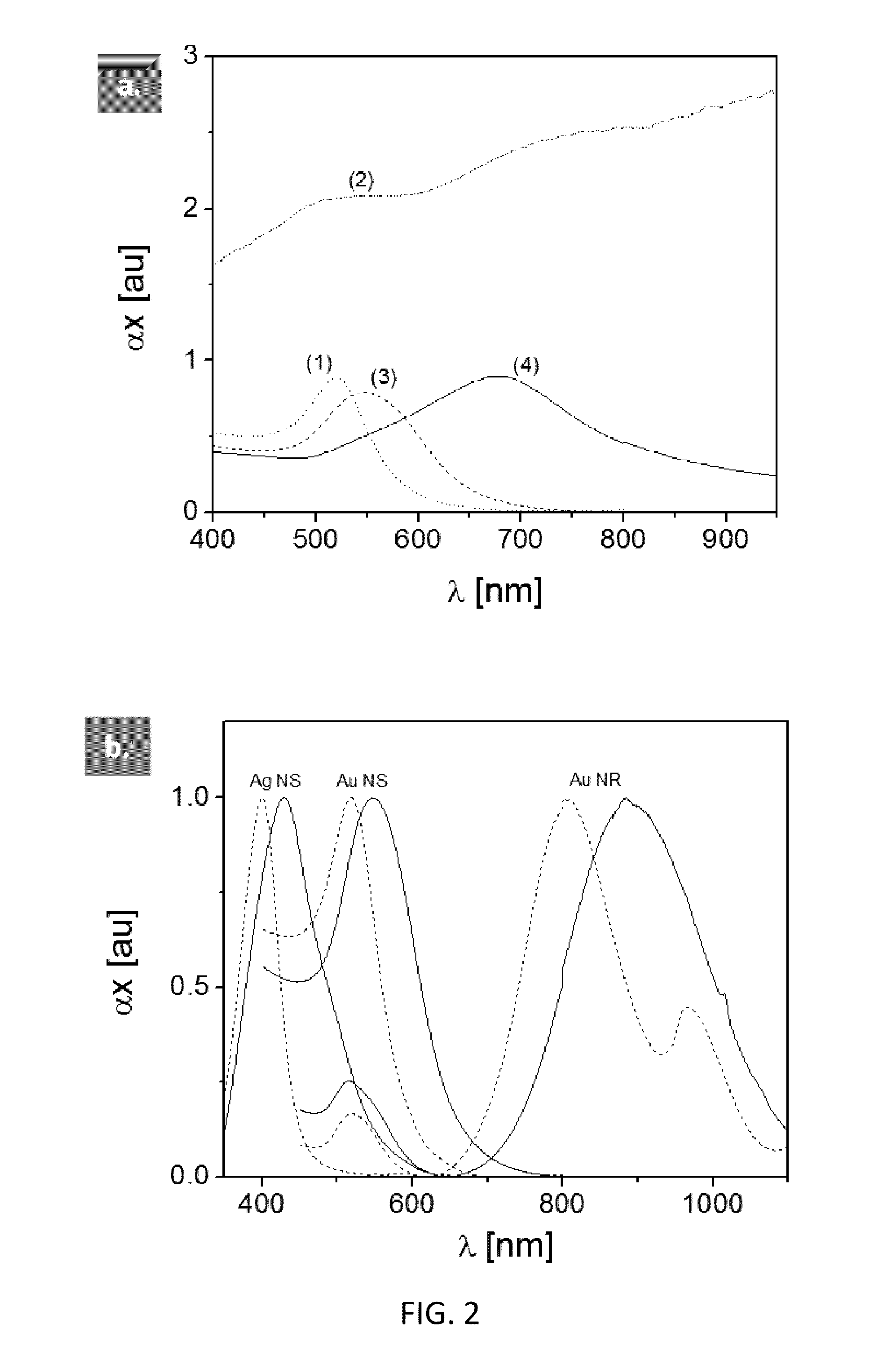Self-Assembly of Metallic Nanoparticles Into Macroscopic, High-Density, Monolayer Films
a technology of metallic nanoparticles and monolayer films, applied in the field of engineering materials, can solve the problems of complex process, time-consuming, expensive, and limited particle resolution of structures, and achieve the effects of reducing the number of particles, reducing the cost of production, and increasing the cost of production
- Summary
- Abstract
- Description
- Claims
- Application Information
AI Technical Summary
Benefits of technology
Problems solved by technology
Method used
Image
Examples
example 1
Phase Transfer of Gold Nanospheres
[0039]Typically, 1 ml of concentrated aqueous nanosphere suspension (e.g. 17 nm Nanopartz Accurate Spherical Gold Nanoparticles, citrate-stabilized, volume fraction=10−5) is placed in a 20 ml borosilicate glass vial. In a separate 5 ml borosilicate glass vial, typically 5 mg of SC6V (FIG. 7b) (see J. Lub et al, Liebigs Ann. Recl., 1997, 2281, incorporated herein by reference) is dissolved in 1 ml of tetrahydrofuran (THF). The SC6V-THF solution is added to the aqueous nanoparticle suspension and the mixture is vigorously shaken for 30 s. Gold nanosphere films then form at the air-fluid interface and travel up the sides of the vial. After substantially all of the gold nanospheres were removed from the solution, FIG. 1d, the remaining solution at the bottom of the vial can be decanted and nitrogen is used to quickly evaporate any residual fluid. The side of the vial was washed with 1 ml of chloroform and sonicated for 60 seconds. The gold nanospheres w...
example 2
Phase Transfer of Metallic Nanoparticles
[0040]The process was also used for anisotropic nanoparticles such as gold nanorods, and silver nanospheres FIG. 2b, demonstrating metallic nanoparticles of different size, shape and composition worked well with this process. Gold nanospheres from Nanopartz, BBI international and SPI worked equally well regardless of the ionic surfactants.
example 3
Transport of Gold Nanosphere Monolayer Films onto Substrates
[0041]Gold nanospheres were transported onto 12×25 mm glass and silicon substrates by adding the substrate to the vial prior to mixing, as in FIG. 1a. After shaking the gold nanosphere films translated up the substrates similarly to the sides of the glass vial, seen in FIG. 1e. If the substrate was hydrophobic, such as Teflon, then film transport onto the substrate would not occur, and the nanoparticles would be confined to the air-fluid interface.
[0042]The absorbance for the nanosphere film on a glass substrate, FIG. 1f (bottom), was measured with results shown in FIG. 2a (solid black line). From the absorbance the thickness of the films can be determined. If the nanospheres are assumed to be a hexagonally packed, the number density can be estimated to be ρ=2.8×1023 [NP / m3]. The absorption cross-section was provided from calculations (Nanopartz, Inc.) to be σ=9.0×10−17 [m2]. The film thickness was then calculated to be x=α...
PUM
| Property | Measurement | Unit |
|---|---|---|
| Length | aaaaa | aaaaa |
| Pressure | aaaaa | aaaaa |
| Density | aaaaa | aaaaa |
Abstract
Description
Claims
Application Information
 Login to View More
Login to View More - R&D
- Intellectual Property
- Life Sciences
- Materials
- Tech Scout
- Unparalleled Data Quality
- Higher Quality Content
- 60% Fewer Hallucinations
Browse by: Latest US Patents, China's latest patents, Technical Efficacy Thesaurus, Application Domain, Technology Topic, Popular Technical Reports.
© 2025 PatSnap. All rights reserved.Legal|Privacy policy|Modern Slavery Act Transparency Statement|Sitemap|About US| Contact US: help@patsnap.com



